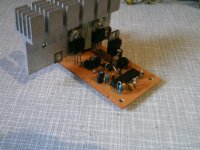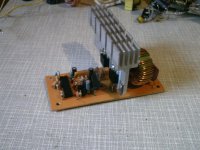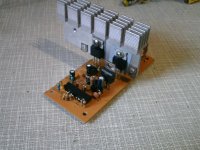Hey Guys.
I am trying to make a D-Class Power Amplifier to drive a 10W 8 Ohm Loudspeaker. However, I want to make the class D Amp using only TL494, BJT's and MOSFETS. The reason is that in my area, specific IC's are hard to come by. Therefore, I need to make use of only BJT's, MOSFETS, other passive components and the TL494 chip.
I am attaching a pic of my LTSpice Simulation, and the Simulation file itself as well. I cannot figure out what I am doing wrong. I have wandered aimlessly around websites but cannot not find a reasonable answer. Please Help... 😕

P.S: If you want the TL494 LTSpice Model, I am attaching the whole library that contains it as well. Thank you so Much.....
I am trying to make a D-Class Power Amplifier to drive a 10W 8 Ohm Loudspeaker. However, I want to make the class D Amp using only TL494, BJT's and MOSFETS. The reason is that in my area, specific IC's are hard to come by. Therefore, I need to make use of only BJT's, MOSFETS, other passive components and the TL494 chip.
I am attaching a pic of my LTSpice Simulation, and the Simulation file itself as well. I cannot figure out what I am doing wrong. I have wandered aimlessly around websites but cannot not find a reasonable answer. Please Help... 😕

P.S: If you want the TL494 LTSpice Model, I am attaching the whole library that contains it as well. Thank you so Much.....
Attachments
Ah, hello Acca. 🙂 Nice to see you're still messing around with this.
I've taken a rather long break but now that i have some spare time i have revisited the project in the past week or so.
I have designed a decent PCB and moved all my components from the other one. There is now room for all the parts that were added later on the old one. It works great so far. I made two side by side so i can make a bridged amplifier working at 12 volts, as my goal now is to make some small powered speakers with two 2" drivers each.
I have bought these little speakers for like $2.50 a pop, and found them to sound brilliant for what they are. They are very bright, clean and can handle a bit of power. I have bought several other 2" speakers in the past from the same store and they sounded like crap, so i abandoned the project. But these ones are better than expected, so i will be buying more of them and building a few speakers. I will also likely build a small subwoofer to make a 2.1 system with them. I do have two 8" subs installed in my desk, but i can't always play that coz it bothers the neighbors, so i want something smaller and lower power.
So i thought that it would be a good idea to use the TL494-based amp for these speakers, as it would be rather small and very efficient. It will be running bridged at 2 ohms (4 ohm speakers wired in parallel). I'm currently in the process of populating the second PCB, and then i have to build the bridging circuit before i can test the whole thing.
If it ends up good, i will share the PCB, but i will leave some part values out for people to experiment with. It's a simple circuit anyway, there are not too many variables. And also, maybe someone ends up with better values than i did. 🙂
I've taken a rather long break but now that i have some spare time i have revisited the project in the past week or so.
I have designed a decent PCB and moved all my components from the other one. There is now room for all the parts that were added later on the old one. It works great so far. I made two side by side so i can make a bridged amplifier working at 12 volts, as my goal now is to make some small powered speakers with two 2" drivers each.
I have bought these little speakers for like $2.50 a pop, and found them to sound brilliant for what they are. They are very bright, clean and can handle a bit of power. I have bought several other 2" speakers in the past from the same store and they sounded like crap, so i abandoned the project. But these ones are better than expected, so i will be buying more of them and building a few speakers. I will also likely build a small subwoofer to make a 2.1 system with them. I do have two 8" subs installed in my desk, but i can't always play that coz it bothers the neighbors, so i want something smaller and lower power.
So i thought that it would be a good idea to use the TL494-based amp for these speakers, as it would be rather small and very efficient. It will be running bridged at 2 ohms (4 ohm speakers wired in parallel). I'm currently in the process of populating the second PCB, and then i have to build the bridging circuit before i can test the whole thing.
If it ends up good, i will share the PCB, but i will leave some part values out for people to experiment with. It's a simple circuit anyway, there are not too many variables. And also, maybe someone ends up with better values than i did. 🙂
Ill make new scheme, because I tried better one, it use lm393,because it can modulate 0-100% signal.
Not really. It suffers from most of the same limitations. Also, the TL494 can be clocked externally making multiple channels easier.
My bridge is currently working, but there is something wrong with the second board, it is distorting a bit. Likely it is due to the fact that i used just random transistors as i was short of one 2N3904 and one 2N3906. Checking it on the scope now.
The noise performance of the bridge is much better than the single-ended one. I clocked the second board from the first one, and since they are operating in antiphase, most of the garbage that gets in cancels itself out. If i can stop it from distorting it'll be perfect. 🙂
My bridge is currently working, but there is something wrong with the second board, it is distorting a bit. Likely it is due to the fact that i used just random transistors as i was short of one 2N3904 and one 2N3906. Checking it on the scope now.
The noise performance of the bridge is much better than the single-ended one. I clocked the second board from the first one, and since they are operating in antiphase, most of the garbage that gets in cancels itself out. If i can stop it from distorting it'll be perfect. 🙂
By the way, just throwing it out there: In most simple, hobbyist-level class-D audio circuits, 0-100% modulation is actually not a good idea. It is better to have for example 5-95%, or maybe 2-98%, if your drivers are behaving well.
I'll let you think of why. Then i will be back with the explanation. 🙂
I'll let you think of why. Then i will be back with the explanation. 🙂
I have lot work about D class,and l see that is better with op than 494.l have good drivers and l not care about modulation.l dont use feedback,as it work better without it ( l check on scope too). When use same triangle osc,clocking is easy.
Según el voltaje de alimentación y el que menor Rs On
According to the supply voltage and the smaller Rs On
According to the supply voltage and the smaller Rs On
hello why i can't run TL494?
it show "could not open library file "..\sym\Valvol\ValVol.lib"
thank you for suggestions
it show "could not open library file "..\sym\Valvol\ValVol.lib"
thank you for suggestions
You .can't modulate it by this way.You can try this:
I did build this design from parts extracted from an old computer power supply including the choke and purchased a bunch of TL494 devices for cents each. Using a breadboard this worked first time, the driver FET does get a little warmbut I did get the amp to run quite nicely at 15 volts up to 30Volts and did not take long to patch together. The sound quality was really very good despite not having a perfect filter (had about 20mv of 100Khz ripple with the bits I had at hand) and the bass was really excellent. If this was used in a general purpose stereo it would not be too shabby
I tried regulating the supply to the 'driver side' to get some control over the heat but the circuit did not behave as well so not sure quite how the design is working so any technical background would be helpful however I intend to play with a proper driver as a primary playground.
Thanks for posting this...
If you already got some kind of small heatsink and it still gets warm, you probably have to adjust the dead time. That's done via the voltage on pin 4 (DTC, dead time comparator input voltage). The datasheet (PDF) says more about that.
- Status
- Not open for further replies.
- Home
- Amplifiers
- Class D
- Class D AMP using only TL494



